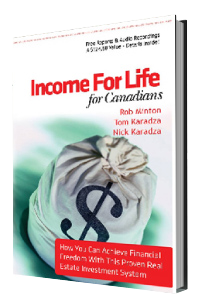Occupancy Agreement Forms: These Agreements Versus Lease Agreements
Occupancy Agreement Forms Vs.
Lease Agreement Forms
Occupancy Agreement Forms Vs. Lease Agreement Forms
Over the past several months, multiple investors have approached us with the idea of using “Occupancy Agreement forms” for their Rent-to-Own properties instead of the more common “Lease Agreement”.
The thinking behind their idea goes like this:
1. With an Occupancy Agreement, you won’t be bound by the Ontario Tenant Board and the regulations it has regarding the treatment of Tenants.
2. So if a tenant is late on their rent you won’t have to go through the N4 process (which gives tenants 14 days to pay late rent) and the L1 process (which sets a date with the Tribunal to get a formal eviction notice).
3. Instead you can just request that the tenant leaves and if they don’t obey you can call the Police to remove the tenants quickly because they are technically trespassing on your property. Although we like the idea of having means to quickly deal with tenants who are not paying us we thought we should investigate this idea of using Occupancy Agreements before we start using them ourselves. We decided to put on our detective hats and play
Sherlock Holmes. For clarification the only visible differences between the two agreements is that one says “Occupancy Agreement” at the top and the other says “Lease Agreement”. And instead of referring to the person moving into the property as “Tenant” they are referred to as “Occupant.” So the first thing we did was call the Hamilton Police.
We spoke to several different departments within Hamilton Police asking them what they would do if we called them about someone living in a residential property that we owned.
We stated that they would be living there as part of an Occupancy Agreement forms we had with them and asked if we could request that they come by and get the people out of our property if they stopped paying us under the Occupancy Agreement forms we would have in place with them. The Hamilton Police responded that it would be outside of their jurisdiction to do that without some sort of “court order”. They would respond to any domestic incidents in the home but they couldn’t remove anyone from a property permanently without some sort of instruction and would refer to the matter to the Sherriff’s department of the local Court House. Hmmm…. We weren’t convinced that they knew exactly what we were trying to accomplish so we plowed forward.
Next we called the Ontario Landlord & Tenant Board. We explained that were planning to rent out a property using an Occupancy Agreement forms instead of Lease Agreement and wanted to know how that affected the relationship we had with the Landlord & Tenant Board.
They explained about the occupancy agreement forms that:
1. As long as money was being exchanged for use of the property the person/people in the property were considered Tenants and bound by the Landlord & Tenant Board no matter what the agreement between us was called.
2. This applied even if they were living in our own property. If they used a separate bathroom and a separate kitchen from us then they were considered Tenants (even in our
own home).
Interesting.
But calling the Landlord & Tenant Board for answer on this matter is like calling a Lawyer asking if you should sue someone or asking a Dentist if you should brush after every meal! :-)
So we pressed on.
We reached out the Landlord Self Help Center (www.LandlordSelfHelp.com) which is an excellent free resource for you as an investor. Here’s how the describe themselves, “A non-profit community service staffed by Lawyers serving small-scale landlords exclusively.”
Over the years we used them many times for advice and they have been fantastic—we highly recommend them.
Knowing that they have a “landlord’s” interests in mind we thought they would be a good resource to reach out to.
We posed our question about using Occupancy agreements forms instead of Lease agreements and here’s what we got back:
“Regardless of the name given to the contract, if there is an offer and acceptance, and a consideration (rent) is paid or given for the right to occupy a residential rental space, then that contract IS covered by the Residential Tenancies Act (RTA), 2006. Section 2 of the RTA has a very broad definition of "rent". If a person is occupying such a space but NOT paying anything (e.g even utilities, mortgage or tax payments), NOR doing any work in lieu of rent, then it would not be a tenancy agreement. Typically this usually only happens with relatives. The Landlord and Tenant Board has the power to interpret such agreements and determine whether or not the RTA applies, regardless of the wording of the agreement.”
And there we have it.
For now we have to conclude that if money is being exchanged for someone to occupy a property everyone is bound by the Residential Tenancies Act and under the jurisdiction of the Landlord & Tenant Board in Ontario.
So we’ll continue using Leases and referring to Tenants as Tenants! If you have any questions or concerns be sure to check this with your own real estate Lawyer.
Over the years we’ve actually found that following Ontario’s system hasn’t been very painful as we first imagined anyway. In fact the entire process has been a pleasant surprise to us.
The N4 process and L1 process that the Landlord & Tenant Board uses is very straight forward and it gives us a well laid out plan for dealing with late rent.
We have used the process many times with great success.
In fact, one time, a Vice Chairman of the Landlord & Tenant Board reviewed our Lease and Option agreement during a hearing and found nothing wrong with them. The Tenant was deemed to be in fact a “tenant” and had to pay our rent as outlined or be evicted from the property.
So there’s even precedent set for these agreements in Ontario.
We’ll continue to explore all ways for managing our properties and if there are better ways to word agreements we’ll be sure to keep all of us informed.
There are also some real cash flow advantages to using a Lease Agreement which we’ll share in an upcoming newsletter—stay tune!
Return from Occupancy Agreement Forms to the Real Estate Investing Guide by clicking here.
Some Cool Free Stuff...
Step 1:
|
Grab a free digital copy of our real estate investing book, Income For Life For Canadians, right here. This book has been downloaded over 22,597 times and has helped hundreds of investors kick-start their investing with simple and straight forward strategies that you can implement right here in Canada. |
 |
|
You'll also receive our weekly [Your Life. Your Terms.] email newsletter with the latest investing updates and videos. |
Step 2:
|
Free Weekly Investing Videos & Articles: Get the latest updates and join the over 10,000 other Canadians enjoying the weekly [Your Life. Your Terms.] email newsletter. The email is sent out each Thursday. And as a little bonus we'll give a FREE digital copy of the book, Income For Life For Canadians, too! |
Your Life. Your Terms.
Step 3:
|
Free LIVE Investing Class: Do you live in the Greater Toronto or Golden Horseshoe Area? Come out to our next introductory "Investing in Nice Homes in Nice Areas" Real Estate Class. |
 |
|
It's 90-minutes and you'll learn a ton - promise!Thousands of investors have now joined us for this class and the feedback has always been amazing. |



